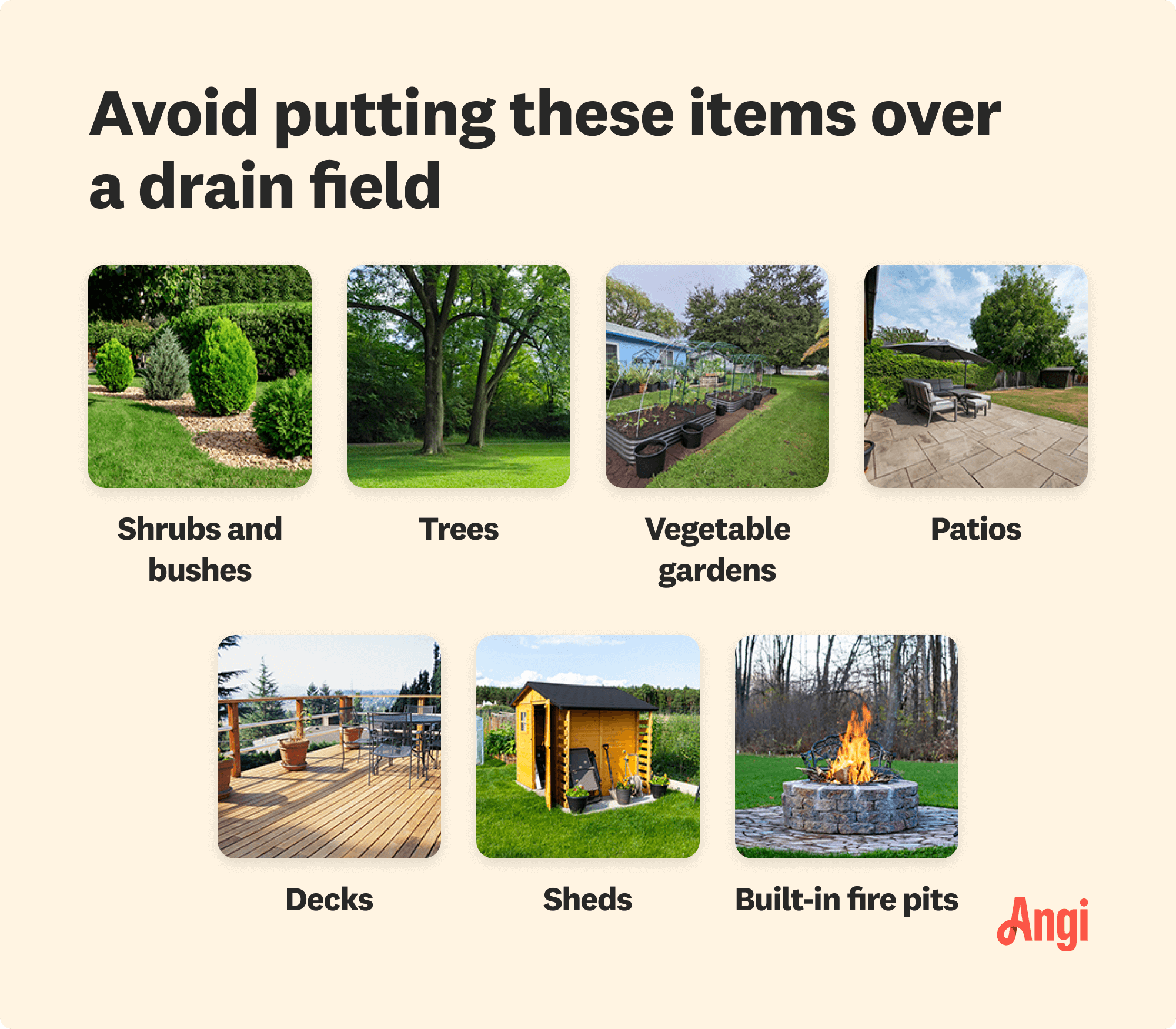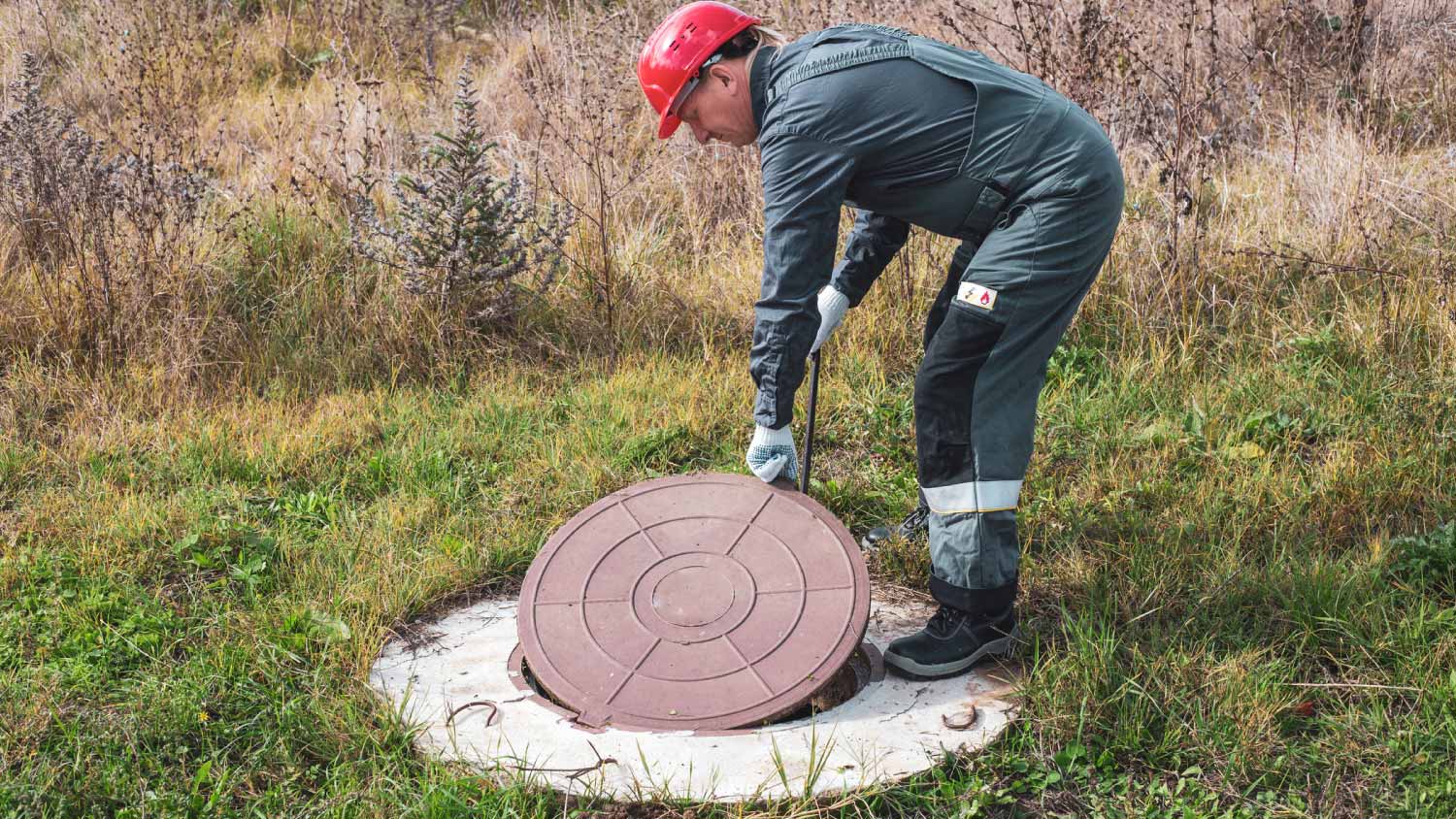
A damaged septic system can leak odors and sewage, so repairs are urgent. Find out how much septic tank repair costs based on repair type, tank size, and more.
Grass is great and flowers flourish, but avoid shrubs and trees over leach fields


Planting grass over your leach field is the most common option and won’t damage the equipment.
A flower garden is a great option, and the nutrients from the leach field can create rich soil for flowers.
Avoid trees, bushes, and shrubs, as the roots can disrupt the perforated pipes.
Avoid installing heavy landscaping features over your drain field, as they can collapse the pipes.
Many homeowners hyperfocus on septic tank health, and while that’s important, the septic drain field or leach field is just as crucial to take care of. Your drain field sits under a large portion of your property, and knowing where it is is important for maintaining septic system health and functionality. Explore what you can put on top of a septic field, what you can't, and how to avoid damage to your system in the process.
When waste flows out of your home, it flows out of your sewer main line and enters into a multi-chamber septic tank before it reaches your leach field. A few things happen in the septic tank:
Solid waste separates from liquid waste
An air compressor aerates the liquid waste (in an certain types septic systems)
Bacteria in the tank break down the organic matter
As this process comes to an end, a pump moves the partially treated liquid waste to the drain field. This consists of a series of perforated pipes that run under the ground. The waste exits the pipes and mixes with bacteria in the surrounding soil, which finishes treating the waste. The water eventually soaks back down into the groundwater.
Now that you understand the basics of how a septic leach field works, you can plan out what landscaping features you can plant over the field. You want to plant lightweight vegetation over the drain field that either has very shallow roots or doesn’t have woody roots that could grow into the perforated pipes, creating clogs or breaks.

Planting grass over your drain field is one of the best and most common options. Grass won’t put your leach field at any risk of damage for a few reasons:
It’s super lightweight
Its roots are shallow
Its roots aren’t strong enough to break your drain field pipes
Plus, most drain fields are located in the middle of the rear yard, so most homeowners will want this area covered with grass anyway.
Flower beds are another popular option for placing over septic system leach fields. The bacteria surrounding the leach field and the effluent coming out of your perforated pipes will keep your soil beautifully fertilized, so flowering plants should have no issue thriving over a drain field.
Similar to grass, flowering plants aren’t terribly heavy, and they have relatively weak, shallow roots that won’t pose any danger to the pipes.
In addition to vegetation, you have the option of installing lightweight landscaping features over your drain field. Some options include the following:
A non-permanent, lightweight swing set
Open-air dog run
Small fences (just be sure the posts don’t go too deep)
Whenever you place structures over your drain field, you might want to call a septic tank company near you to inspect the drain field and make sure what you’re installing won’t be too heavy over the buried pipes. A professional can also help you dig holes for installing fence posts or other structural components without damaging your leach field.

Septic system drain fields are somewhat delicate, so the list of landscaping features you shouldn’t put over them is longer than the things you can.
Septic system leach field pipes sit between 6 and 36 inches under the ground, often at a depth of a foot and a half. As such, planting any vegetation with woody root systems isn’t recommended, as the roots can easily damage the pipes.
Roots from trees and larger bushes are especially problematic because they can crack the drain field pipes and cause the effluent to seep into the ground too quickly. This could pose an issue for water quality.
Vegetable gardens might seem like a great option for planting over a septic drain field because they’re lightweight and have shallow roots, but it’s not recommended. According to the University of New Hampshire, the effluent can contaminate the soil if you run into issues with leaks, at which point it would be unsafe to eat the produce.
You should also avoid any heavy landscaping structures over leach fields, as the weight of concrete, pavers, and other dense building materials can compact the soil and crush the drain field pipes, leading to serious issues.
Some landscaping features to avoid over your leach field include the following:
Paver patios
Flagstone patios
Concrete patios
Decks
Concrete or paver walkways
Pools and spas
Built-in fire pits
Sheds
Keeping your leach field in good working condition doesn’t take a lot of work, but it does take some careful planning and ongoing maintenance. Follow the tips below to help make sure your drain field continues to work properly for years to come:
Only plant grass and lightweight plants with non-woody roots over the field
Avoid patios, walkways, decks, and other heavy structures above the drain field
Don’t plant trees or bushes within 10 feet of the leach field
Have a septic system inspection done every two to three years
Report issues with sewage backups, a soggy lawn, or unusually green grass over your leach field immediately
It takes some money and effort to maintain your leach field, but doing so will almost always be more affordable than the cost of a new septic system.
Knowing that a new riser was to be installed at the house I was selling, I wanted the service man to take a quick look at a boggy spot in my new yard. I called Arness' office and spoke to Patty. She offered to send someone out to my new house right away. Arness is located in the next town. I...
I have used Lakeside Septic for 20 years, He has always been on time and done a good job.... would use no one else.
This company knows NOTHING about Glendons. They will tell you they work with Glendons all the time, but everything they ever told me was wrong. It wasn't until I went with All County Septic that I finally started seeing improvements in my Glendons. The final episode with Northwest Septic...
Ferrellgas installed our propane tank last summer and things went fine. No complaints no kudos. The gas piping was performed by another company who recommended Ferrellgas. We ordered propane in early december and they did not fill our tank as requested, but only brought it up to about 65%...
Mike Nelson has had his hands in everything! You can't put what he knows in a computer. He is priceless. They are tough to schedule as they don't come out fast, but nothing I've ever needed was an emergency. But they do show up when they are scheduled to be there. However, I had a horrible...
From average costs to expert advice, get all the answers you need to get your job done.

A damaged septic system can leak odors and sewage, so repairs are urgent. Find out how much septic tank repair costs based on repair type, tank size, and more.

Roto-Rooter plumbing services can help you unclog drains, fix leaks, or provide remediation services after a flood. Learn the average cost to hire a local specialist and how they can help you.

Sewer cleanout costs depend on the type of cleanout and how long the line will be. Click here to start planning your budget for this project.

A perc test for septic analyzes the absorption rate of the soil where a tank is going to be installed. Learn more about the test, cost, and passing grades.

Deciding between a concrete and plastic septic tank involves considering both long-term and short-term variables. Here's what you need to know about both types.

If you’re building a new home or experiencing ongoing plumbing issues, you’ll need a septic tank pro. Review these questions to ask about septic systems.